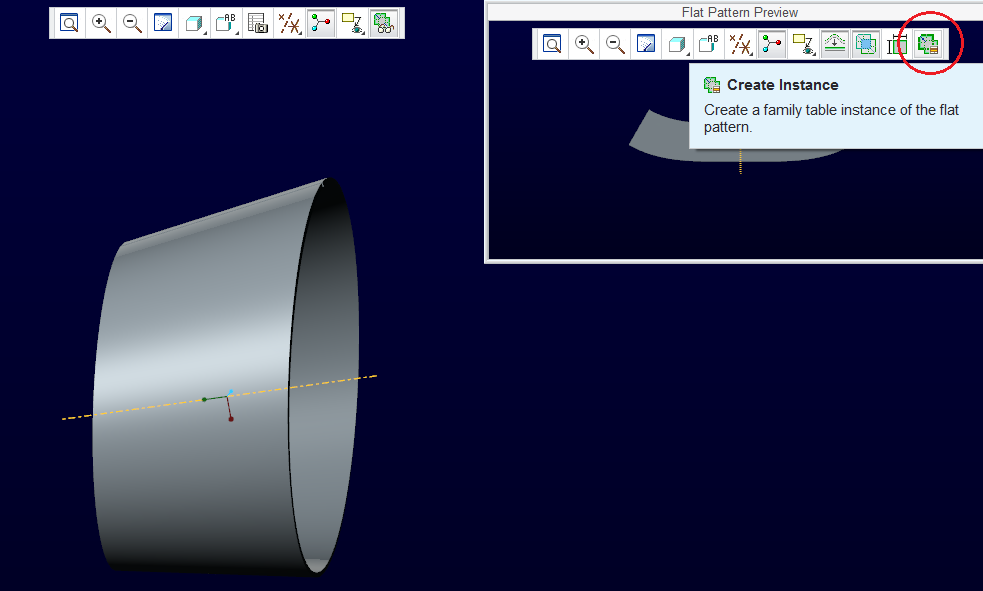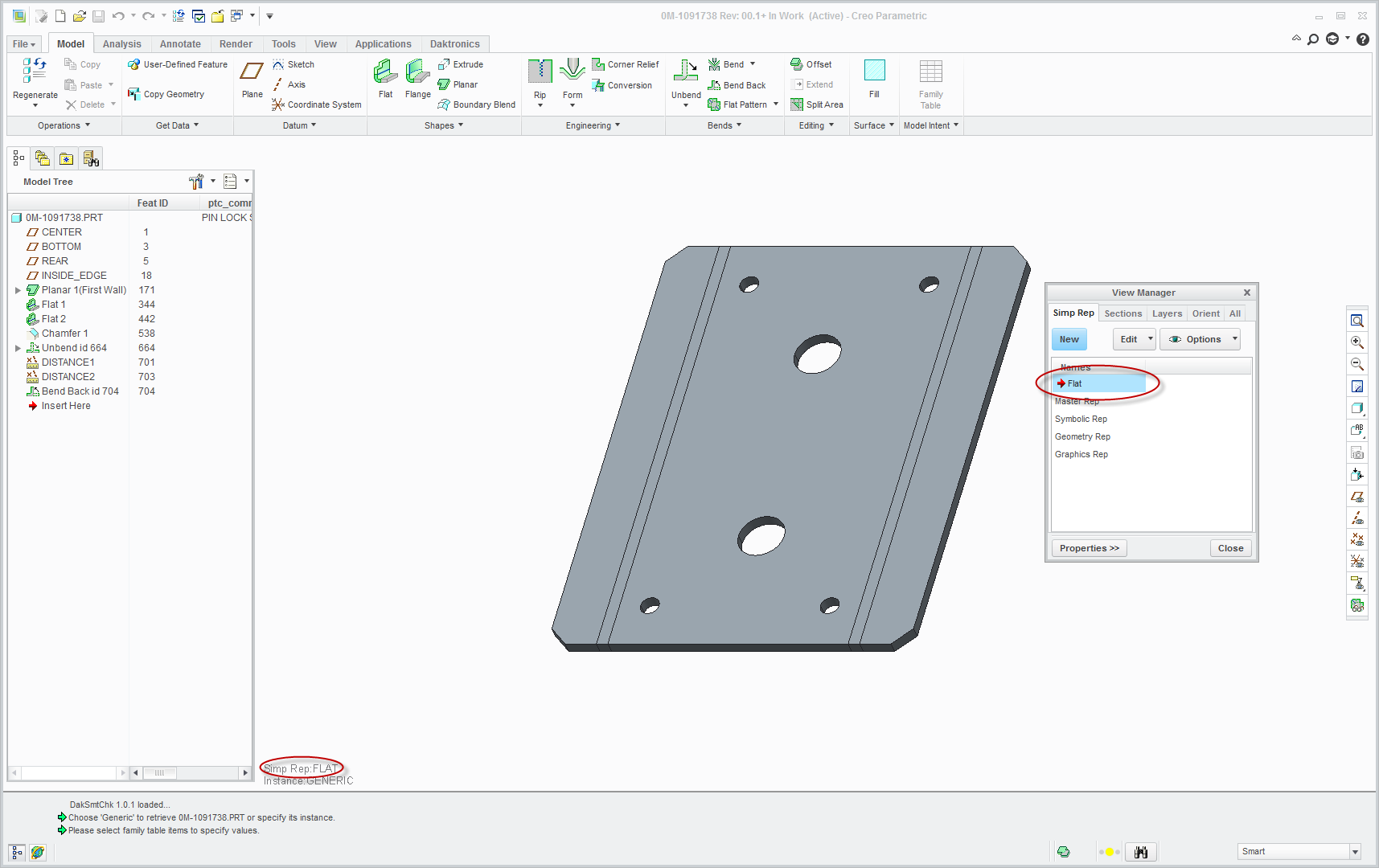Community Tip - When posting, your subject should be specific and summarize your question. Here are some additional tips on asking a great question. X
- Community
- Creo+ and Creo Parametric
- 3D Part & Assembly Design
- Re: Creo 2.0 - Q: Is the flat state easier to crea...
- Subscribe to RSS Feed
- Mark Topic as New
- Mark Topic as Read
- Float this Topic for Current User
- Bookmark
- Subscribe
- Mute
- Printer Friendly Page
Creo 2.0 - Q: Is the flat state easier to create in PTC Creo than in Wildfire 5?
- Mark as New
- Bookmark
- Subscribe
- Mute
- Subscribe to RSS Feed
- Permalink
- Notify Moderator
Creo 2.0 - Q: Is the flat state easier to create in PTC Creo than in Wildfire 5?
This is a question answered by PTC from a webinar PTC Creo 2.0 in Action!
14. Q: Is the flat state easier to create in PTC Creo than in Wildfire 5?
A: The unbend and flat pattern tools have been greatly improved to facilitate the creation of the flat states. Single button action to create a flat pattern family table instance or part simplified rep to show in detailing.
Is there really a single button action to create simplified rep of flat pattern which can be shown in drawing?
This thread is inactive and closed by the PTC Community Management Team. If you would like to provide a reply and re-open this thread, please notify the moderator and reference the thread. You may also use "Start a topic" button to ask a new question. Please be sure to include what version of the PTC product you are using so another community member knowledgeable about your version may be able to assist.
- Labels:
-
General
- Mark as New
- Bookmark
- Subscribe
- Mute
- Subscribe to RSS Feed
- Permalink
- Notify Moderator
Yes there is.
- Mark as New
- Bookmark
- Subscribe
- Mute
- Subscribe to RSS Feed
- Permalink
- Notify Moderator
Ha ha....ok...can you elaborate your answer and tell me where to find it?
- Mark as New
- Bookmark
- Subscribe
- Mute
- Subscribe to RSS Feed
- Permalink
- Notify Moderator

- Mark as New
- Bookmark
- Subscribe
- Mute
- Subscribe to RSS Feed
- Permalink
- Notify Moderator
No, that will create a family table instance not a simplified rep. I'll post my question again.
Is there really a single button action to create simplified rep of flat pattern which can be shown in drawing?
- Mark as New
- Bookmark
- Subscribe
- Mute
- Subscribe to RSS Feed
- Permalink
- Notify Moderator
The answer is no. There is not a single buttone to do so without the creation of a mapkey. However one you create the simplified rep, it is done for all family table members.
The issue i see with this though is that your master rep is flat not formed. I have brought this up at the TC meetings a couple of times and presented on this in January to one of the project managers and the sheetmetal TC. Hopefully this is fixed sooner than later.
Andy
- Mark as New
- Bookmark
- Subscribe
- Mute
- Subscribe to RSS Feed
- Permalink
- Notify Moderator
Maybe you can be more specific about "which" simplified rep you want. By default there are 4. When you create the family table instance, you also get 4 "simplified reps" in the View Manager. Technically, this answers your question but there is a family table involved.
I have done drawings using view states rather than simplified reps or family tables. If you avoid the "flat pattern" feature and use unbend and bend back features, you can easily make a view state with the flat pattern (unbend) view state and by suppressing the "bend back" feature in that state. This way, your default master model is in the bent, or as-used state.
I am always leery of "one button" claims as they are often not ideal. The method I describe here is actually quite simple if you have the discipline to make sure your model will support the unbend/bend-back features.
- Mark as New
- Bookmark
- Subscribe
- Mute
- Subscribe to RSS Feed
- Permalink
- Notify Moderator
Thanks Antonius, I was mostly questioning PTC representative reply stating that ther is a single button action to create a simplified rep. If it did exists it would be simpler for us to create flat states than using the unbend/bend back reps that we're using today. It seems to be similar to what you describe.
I'm not sure I follow you on View States vs Simplified Reps. As I understood it View States requires a Combined state which requires a Simplified Rep where the Bend back feature is excluded in a Simplified Rep.
- Mark as New
- Bookmark
- Subscribe
- Mute
- Subscribe to RSS Feed
- Permalink
- Notify Moderator
You are correct. I didn't realize that I was creating simplified reps by defining the view states ![]()
The view state only helps by providing a desired orientation.
I do believe the PTC Rep over-represented the capabilities. You probably have his/her contact information. It would be interesting to see what they -really- meant.
- Mark as New
- Bookmark
- Subscribe
- Mute
- Subscribe to RSS Feed
- Permalink
- Notify Moderator
I should clarify. When i said the master is not formed, that is when used with the flat pattern feature and not the use of unbend and bend back features. When using the later it works fine.
Antonius, I believe the point Magnus is making is that he does not want a flat instance. You can then display the Flat Rep in the drawing.

- Mark as New
- Bookmark
- Subscribe
- Mute
- Subscribe to RSS Feed
- Permalink
- Notify Moderator
I get what you are saying, Andrew.
I don't know how it is in WF but I made a quick video of what I found interesting.
Create the simplified representation, then create the flat pattern feature. Done.
What it actually does is to suppress the flat pattern feature in the master rep. So even though it works in the session, it does -not- work after it is saved and removed from memory. The suppression state is not maintained with simplified reps!
What I did after that was to add a bend back feature after the flat pattern. And if you actually -try- to do this, this too will fail because it maintains the flat pattern as the last feature. -BUT- ...if you add the bend back feature in a simplified rep, it adds the bend back feature -after- the flat pattern feature. THIS the system maintains after a save and erase in memory.
I am not sure what happens to form features in this case but this is as far as I got. I am certain these videos highlight a couple of serious bugs that should be investigated. Andrew, do you sill have some contact information with the Sheetmetal TC committee to have them take a look at these vids?
The moral of this whole post is that the family table method is likely the method referred to when a "single button" process was suggested. I am not one to use family tables in practice (in 15 years, haven't yet!). I am also not certain that the trick to placing the bend back feature after the flat pattern feature will be stable in the long run as Creo gets updated.
- Mark as New
- Bookmark
- Subscribe
- Mute
- Subscribe to RSS Feed
- Permalink
- Notify Moderator
If the suppressed features stayed with the simplified representations, things would be good. But if you have form features, they do not "bend back" after a default flat pattern. You can separate the flatten form features in a separate command by excluding them in the flat pattern creation, but the same problem exists - there is not an "unflattern form features" feature that can be "excluded" in the Simplified rep.
So the method described above also has a limitation that your "flat pattern" for the drawing must have the form features formed. Not that I see this as a problem but it is a limitation. Hiding edges in the drawing can make up for some of this limitation (re-strikes after bending, for instance). For 3D punch features created prior to bending, I have always felt should show up in the flat pattern. This is after all what you hand the brakeman, erm... person, right?
- Mark as New
- Bookmark
- Subscribe
- Mute
- Subscribe to RSS Feed
- Permalink
- Notify Moderator
I am on the TC so i will try and remeber to bring this up.
- Mark as New
- Bookmark
- Subscribe
- Mute
- Subscribe to RSS Feed
- Permalink
- Notify Moderator
Thanks!
- Mark as New
- Bookmark
- Subscribe
- Mute
- Subscribe to RSS Feed
- Permalink
- Notify Moderator
Great Andrew!
I believe that in most other CAD programs you will have a flat state created by default. Creo seems to be really close as the fixed geometry can be choosen by default and that the flat state can be shown in the docked preview window.




